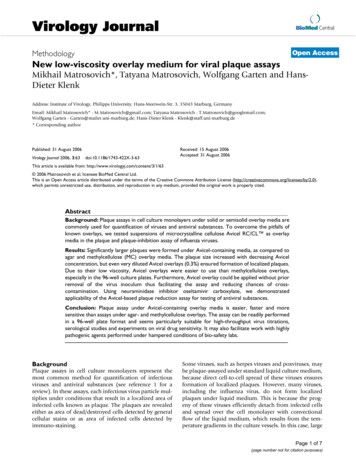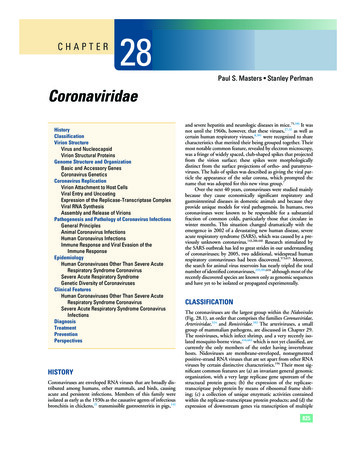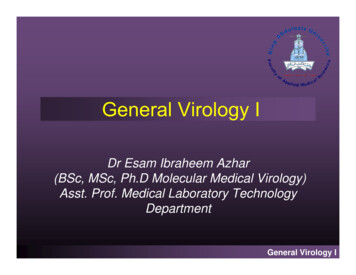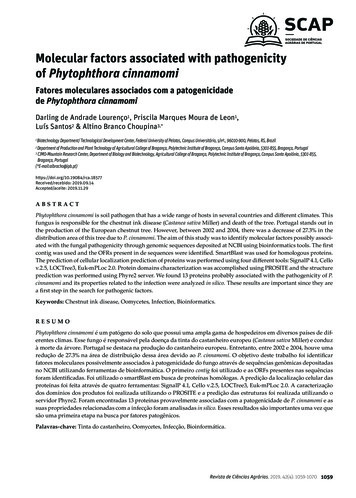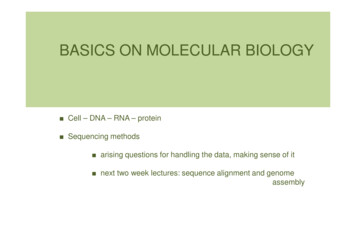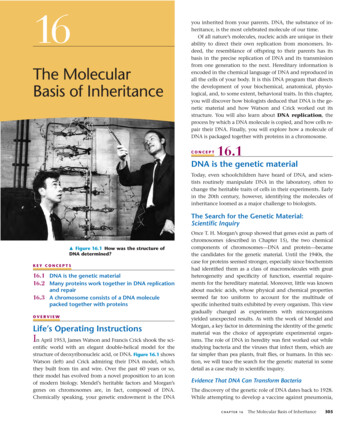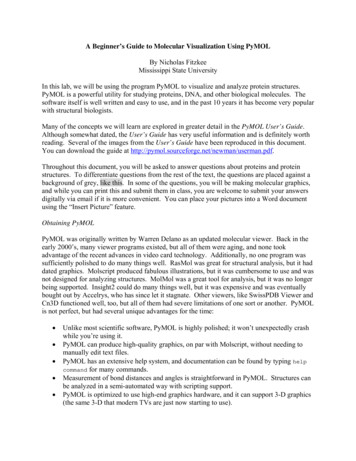
Transcription
QUOTESFROMREVIEWSOFPREVIOUS EDITIONS‘Teaching an undergraduate class in virology has been complicated in recent years by the lack of an adequate general text. . . . Alan J Cann’s new book, Principles of Molecular Virology is built around the paradigms which unite virology as a mature science. For this and other reasons his book is more suitablefor an undergraduate class than any other text I have recently seen. . . . What we have in this book is anavowed effort to concentrate on principles and avoid detail, to provide selective coverage of moderntopics without great expense. In these aims, author and editor meet with success . . . there have beensome valuable side effects to this compression. There are for example, numerous instances in which theauthor extracts a “take-home message” from large bodies of material. These messages are particularlyhelpful to undergraduates dealing intellectually with viruses from the first time, and they provide someuseful models for synthesis.All things being equal, I plan to use Principles of Molecular Virology when I teach virology next year.It is generally well-done, readable and undergraduate-friendly, and it fills a definite niche.’Carl Luciano, ASM News‘. . . In Principles of Molecular Virology, Alan Cann has attempted to tackle some of (these) problemsby providing what is essentially a molecular virology lecture course in a short, straightforward, inexpensive paperback that concentrates on the basic principles of molecular virology. . . . The chapters arewell written and a summary of the important messages is provided at the end of each. The fundamentals are clearly and concisely documented. . . . The author has made a considerable effort to ensure thatthe book is as up to date as possible. . . . An important question is whether this book will have widerappeal than just to the aforementioned undergraduates or young PhD students. I think the answer is yes. . . this volume may provide a good starting point for non-virologists to rapidly acquire a working knowledge of the area.’Ian Brierley, Trends in Biochemical Sciences‘The discipline of virology has just celebrated its centenary, marking the discovery of the first virus byIvanovsky in 1892; since then, thousands of viruses infecting plants, animals and bacteria have been identified and catalogued. Despite this hundred years of study, however, viruses continue to pose seriousthreats to human health, both directly, and indirectly, through their effects on domestic animals and foodplants.Alan Cann has attempted to provide an undergraduate text that has a different organization from thetraditional organisation from the traditional family-by family approach to teaching virology, by describing the “principles” of virology at the molecular level. . . . The volume is compact . . . and realisticallypriced. . . In summary Alan Cann has made a valiant effort to present molecular virology to an undergraduate audience in an easily digestible form, and this book can be recommended as being suitable for mostfirst-degree courses.’Richard M Elliott, Trends in Microbiology‘. . . An excellent framework for an introductory course and an integrated rather than a “virus by virus”account used in many of the larger texts. The methods –based introduction provides a good theoreticalbackground and subsequent chapters are well illustrated. The writing flows easily with good practicalexamples that help hold the interest. Each chapter has a summary and a well-focused reading list. . . .This is an attractive, up-to-date book and is an excellent buy that I can strongly recommend.’Sam Martin, SGM Quarterly‘This book provides an essential introduction to modern virology. Focusing on the new molecularapproach this textbook presents the principles of virology in a clear and concise manner.’Documentation (Technique/Scientifique)‘Principles of Molecular Virology is an excellent virological text for students. I am pleased to see that ithas now gone into a second edition, reflecting its popularity and the rate of progress within the field. Itis recommended in many university undergraduate courses for good reason. It bridges a gap between
the generally superficial virological subsections of undergraduate microbiology books and the enormously comprehensive tomes such as Fields Virology. It is written in an accessible style and the sectionson different aspects of virus structure and virus replication provide a useful counterpoint to the moreclassical systematic description of viruses found elsewhere. In addition, the practical examples are wellillustrated. I suspect the self-assessment questions will be usefully plundered by those setting examinations. In general, the text is very much up to date, and the illustrations are excellent.’Andrew Lever, Trends in Genetics‘To say it in advance of all the details: Alan J. Cann and Academic Press introduce a book which is wellworth its price addressing all individuals and institutions dealing with virology. . . . It, furthermore, provides an introduction especially to those who were not yet confronted with modern aspects of virology. . . The text is easy to follow and represents a fantastic blend of basic principles, corresponding techniques and applied views such as responses to and treatment of virus infection including AIDS. . . . Twoappendices concerning 1) classification of subcellular infectious agents and 2) glossary and abbreviations,together with the nine pages of index undoubtedly increase the value of this booklet both for the studentand the user in applied fields . . . the clear and concise manner of presentation allows an uncomplicatedstudy and understanding of basic principles of molecular virology.’EF Elstner (Weihenstephan), Zeit fur Pflanzenkronkheiten und Pflanzenschutz‘There is a remarkable amount of detail included for so small a book. This well-written text provides avery useable introduction to virology. The information provided is current. It would be a worthwhileaddition to the library of teachers and undergraduate virology.’Jerry L Taylor, DOODY REVIEW‘In this update of the edition with a preface dated 1996, Cann (U. of Leicester, UK) adds new sectionson viruses and apoptosis and bacteriophages and human disease, online resources, a chronology of virology’s history, and a companion CD-ROM with interactive tutorials. Includes prefaces to the previouseditions, self-assessment questions with an answer key, a glossary, and a classification table of subcellular infectious agents.’From Book News, Inc.
Principles ofMolecular Virology4th Edition
ForJoe and Jules
Principles ofMolecular Virology4th EditionAlan J. CannUniversity of Leicester, UKAMSTERDAM BOSTON HEIDELBERG LONDON NEW YORK OXFORDPARIS SAN DIEGO SAN FRANCISCO SINGAPORE SYDNEY TOKYO
Cover image: Sendai virus. Coloured transmission electron micrograph (TEM) ofSendai virus particles (virions, orange). The protein coat (capsid) of one of the particles has split, allowing its RNA (ribonucleic acid ) genetic material (orange strips) to spillout. The Sendai virus is a paramyxovirus. Also known as parainfluenza virus type 1, itinfects mice, rats, hamsters and guinea pigs. It is transmitted by direct contact and inthe air, causing laboured breathing and a decrease in the number of offspring produced.The Sendai virus is also used as a cell-fusing agent in laboratories. Magnificationunknown. Dr Linda Stannard, UCT, courtesy of Science Photo Library.”Elsevier Academic Press30 Corporate Drive, Suite 400, Burlington, MA 01803, USA525 B Street, Suite 1900, San Diego, California 92101-4495, USA84 Theobald’s Road, London WC1X 8RR, UKThis book is printed on acid-free paper.Copyright 2005, Elsevier Inc. All rights reserved.No part of this publication may be reproduced or transmitted in any form or by anymeans, electronic or mechanical, including photocopy, recording, or any informationstorage and retrieval system, without permission in writing from the publisher.Permissions may be sought directly from Elsevier’s Science & Technology RightsDepartment in Oxford, UK: phone: ( 44) 1865 843830, fax: ( 44) 1865 853333,e-mail: permissions@elsevier.co.uk.You may also complete your request on-line via theElsevier homepage (http://elsevier.com), by selecting “Customer Support” and then“Obtaining Permissions.”Library of Congress Cataloging-in-Publication DataApplication submittedBritish Library Cataloguing in Publication DataA catalogue record for this book is available from the British LibraryISBNISBNISBNISBN(Standard Edition): 0-12-088787-8(Instructors’ Edition): 0-12-088789-4(Standard CD-ROM): 0-12-088788-6(Instructors’ CD-ROM): 0-12-088790-8For all information on all Elsevier Academic Press publicationsvisit our Web site at www.books.elsevier.comPrinted in the United States of America05 06 07 08 09 10 9 8 7 6 5 4 3 2 1Working together to growlibraries in developing countrieswww.elsevier.com www.bookaid.org www.sabre.org
thethefourth editionthird editionsecond editionfirst editionxxixiixiiiChapter 1 IntroductionViruses are Distinct from Living OrganismsThe History of VirologyLiving Host SystemsCell Culture MethodsSerological/Immunological MethodsUltrastructural Studies‘Molecular Biology’Further Reading123579121824Chapter 2 ParticlesThe Function and Formation of Virus ParticlesCapsid Symmetry and Virus ArchitectureEnveloped VirusesComplex Virus StructuresProtein–Nucleic Acid Interactions and Genome PackagingVirus Receptors: Recognition and BindingOther Interactions of the Virus Capsid with the Host CellSummaryFurther Reading25252839424953535454
viiiContentsChapter 3 GenomesThe Structure and Complexity of Virus GenomesMolecular GeneticsVirus GeneticsVirus MutantsSuppressionGenetic Interactions between VirusesNongenetic Interactions between Viruses‘Large’ DNA Genomes‘Small’ DNA GenomesPositive-Strand RNA VirusesNegative-Strand RNA VirusesSegmented and Multipartite Virus GenomesReverse Transcription and TranspositionEvolution and EpidemiologySummaryFurther Reading565659626467687173757882848798101101Chapter 4 ReplicationOverview of Virus ReplicationInvestigation of Virus ReplicationThe Replication CycleSummaryFurther Reading102102104108129129Chapter 5 ExpressionExpression of Genetic InformationControl of Prokaryote Gene ExpressionControl of Expression in Bacteriophage lControl of Eukaryote Gene ExpressionTranscriptional Control of ExpressionPosttranscriptional Control of ExpressionSummaryFurther Reading131131132133138150155163164Chapter 6 InfectionVirus Infections of PlantsImmune Responses to Virus Infections in AnimalsViruses and ApoptosisInterferonsEvasion of Immune Responses by VirusesVirus–Host Interactions165166169174177181183
ContentsixThe Course of Virus InfectionsVirus Vectors and Gene TherapyChemotherapy of Virus InfectionsSummaryFurther Reading192199200206206Chapter 7 PathogenesisMechanisms of Cellular InjuryViruses and ImmunodeficiencyVirus-Related DiseasesBacteriophages and Human DiseaseCell Transformation by VirusesViruses and CancerNew and Emergent VirusesZoonosesBioterrorismSummaryFurther Reading208210212221224225236240246247248248Chapter 8 Subviral Agents: Genomes without Viruses,Viruses without GenomesSatellites and ViroidsPrionsSummaryFurther Reading249249253267267Appendix 1 Glossary and Abbreviations269Appendix 2 Classification of Subcellular Infectious Agents281Appendix 3 The History of Virology294Index300
PREFACE TO THEFOURTH EDITIONIn addition to complete updating, this edition of Principles of Molecular Virology contains a number of additions to the text and illustrations; for example, new information on topics such as SARS and bioterrorism. However, most changes havebeen made to the enclosed CD. In addition to complete reformatting, the contenthas been completely revised and we have been able to include for the first time aseries of animations covering important topics such as capsid symmetry, virus replication and immune recognition and killing of virus-infected cells. There is also anew interactive self-assessment quiz for each chapter so you can judge for yourselfyour knowledge of virology.I would like to extend my thanks to the staff of Elsevier for their assistanceduring the preparation of the book. I am confident that readers will find thisedition as useful as the previous ones.Alan J. CannUniversity of Leicester, UKalan.cann@leicester.ac.ukApril 2005
PREFACE TO THETHIRD EDITIONThis edition of Principles of Molecular Virology seeks to build on the success of thefirst and second editions. In addition to complete updating, numerous additions(and hopefully, enhancements) have been made to the text. These include new sections on ‘Viruses and Apoptosis’ (Chapter 6) and ‘Bacteriophages and HumanDisease’ (Chapter 7), the addition of learning objectives for each chapter and a newappendix describing key events in the history of virology (Appendix 3). However,probably the first change most readers will notice is a new format with the addition of colour illustrations to enhance understanding of key points.An exciting new development has been the inclusion of an electronic companion to the book in the form of the enclosed CD. In addition to interactivelearning resources on the CD which complement each chapter, the ‘VirologyOnline’ section has been written to encourage readers with access to the internetto go beyond reading the text of the book to find more information online.I would like to extend my thanks to all of my academic colleagues who havehelped with the preparation of this edition, but in particular I value the contribution of the many people who have contacted me with suggestions and commentsregarding the previous editions. I hope that readers of this edition will continue todo so. I would also like to thank the editorial staff of Academic Press for theirsupport and assistance during the preparation of the book. Finally, I would like toth
mously comprehensive tomes such as Fields Virology. It is written in an accessible style and the sections on different aspects of virus structure and virus replication provide a useful counterpoint to the more classical systematic description of viruses found elsewhere. In addition, the practical examples are well illustrated. I suspect the self-assessment questions will be usefully plundered .
